Yorkshire-class bombardment platform:
Quite a large and sluggish ship that acts as an orbital bombardment platform. It has deployable satellites to target places on the ground. The underside of the ship has massive amounts of armour. It has quite a strong shield. When it takes too much damage it will move outside range. It has a massive amount of exposed radiators on the top side. The ship utilizes weapons that can all fire downwards. Casaba howitzers, railguns, ion cannons, missiles launchers, pretty much the GBEs entire weapons arsenal.
Length: 2 km
Calamity-class cruiser:
Cruiser made for orbital bombardment and fleet combat. The Calamity is made for direct fleet combat and engagements from long to medium range. It uses primarily torpedoes and railguns to rain down fire. The shields are strong and the ship has a modular spinal mount slot in which it can equip the standard particle lance or a unique spinal mount weapon, the arc pacifier cannon, a weapon that intercepts and destroys all shells and missiles in an area. It is also armed with ion missiles for efficiency against enemy shields.
Length: 2 km
Sunrise class cruiser:
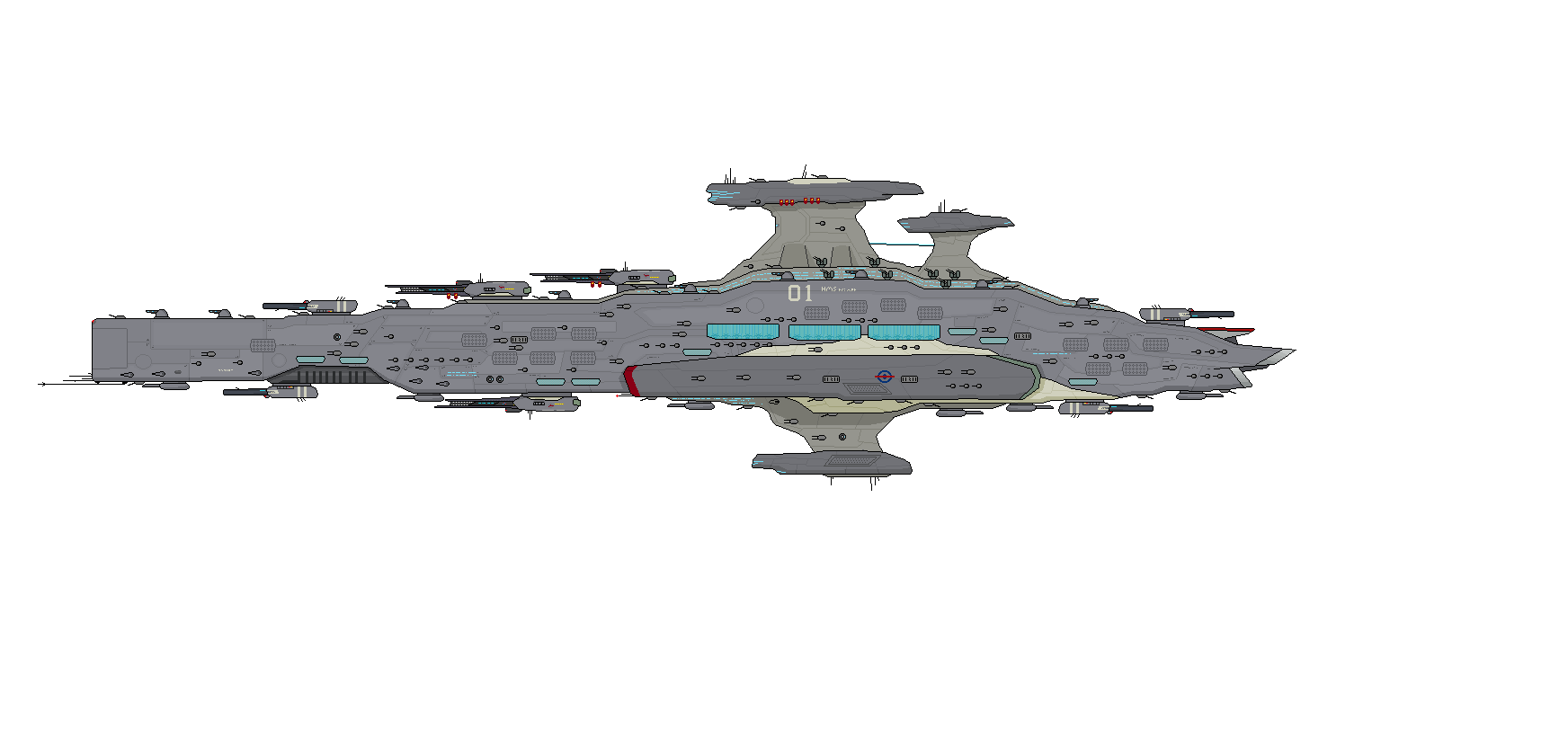
The Sunrise-class cruiser is considered the peak of GBE engineering. With a high upfront build cost and a low upkeep cost, the Sunrise-class is made for long time use. The ship is undoubtedly the most polished and refined ship in the GBEs recent history. The armour used is made with all the knowledge the GBE can muster as well as the best materials the GBE has access to. This ship has proved its effectiveness in combat in training. The ship is less flexible than other cruisers though, making it laser-focused in ship to ship combat. It is not atmospherically capable and it doesn’t have an orbital bombardment cannon. It also lacks many systems which would increase its performance on its own. Instead, it has replaced these systems with shields (six layers), carrier capabilities, repair systems and advanced combat computers. The firepower on the Sunrise-class is unrivalled in the GBE combat doctrine. The particle lance is refined and the railguns are of the newest iteration. The first refit will soon arrive with a 8L 5077 aura shield system which is the BAe latest iteration of shielding, new armour, shell interception methods, new propulsion and modernized versions of the railgun family.
length: 1.7 km
Moonlight-class cruiser:
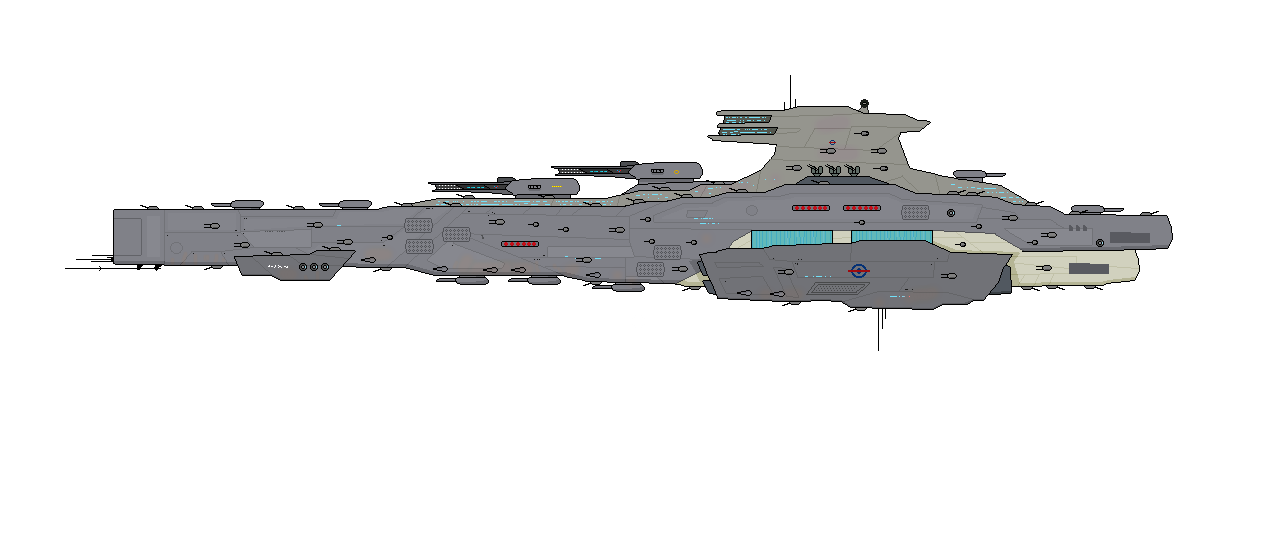
The moonlight-class is a flexible gen III cruiser. The moonlight-class lost the title as mainstay ship because of its high maintenance cost. It has two "wings" to stay stable during atmospheric flight, cruise missiles and precursor to the GBE’s mainstay gen IV main battery.
length: 1.5 km
Eclipse-class cruiser:
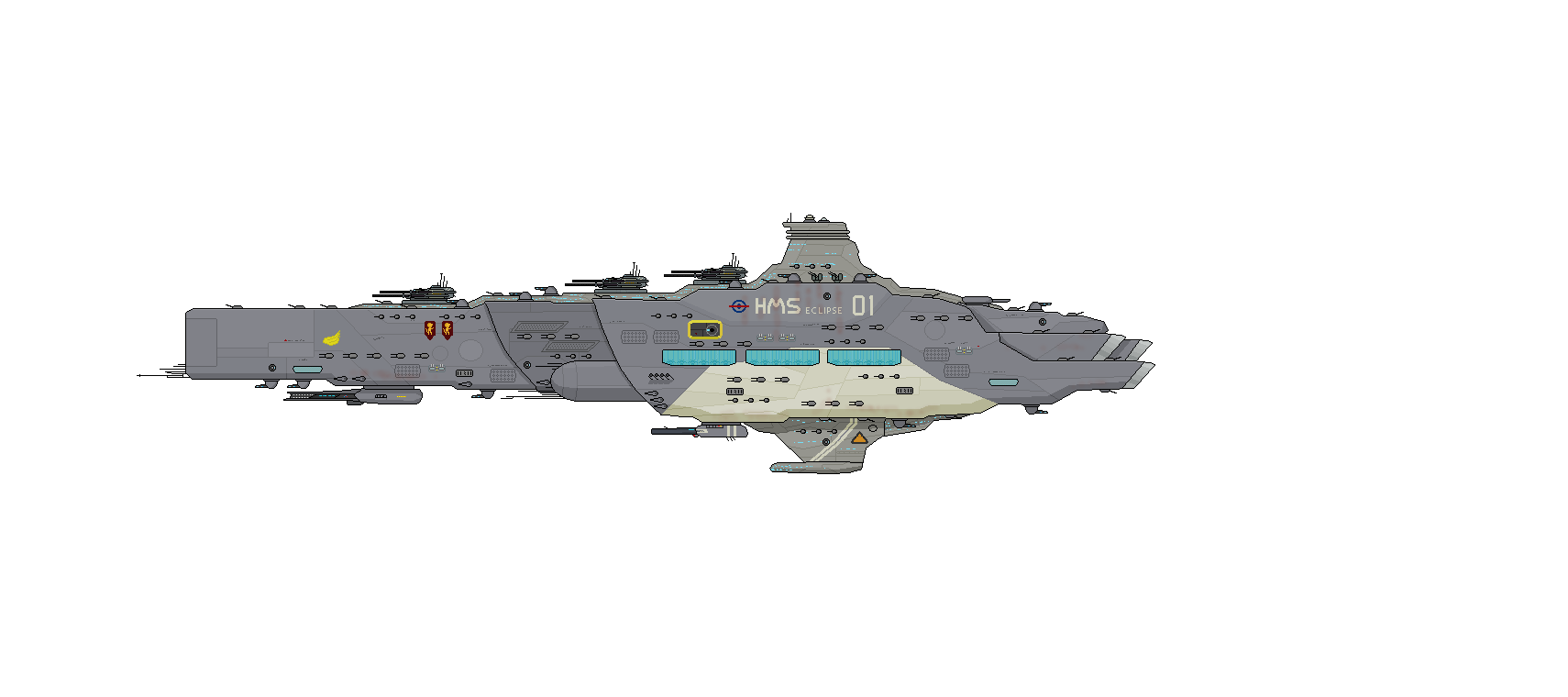
The Eclipse-class appeared first on Judgement Day. It is gen V’s Solaric, a cheap, easy, reliable and flexible ship-class which is the GBE’s new mainstay ship. The ship's cannons have an extremely high fire rate and its detection system is powerful. The ship has new drones to crew the ships that have increased resilience against electronic warfare. New and improved shields with 6 shields layers.
Length: 1.5 km
Eternity-class atmospheric cruiser:
A cruiser that is effective within atmosphere. It excels at medium range combat. It is not armed with torpedoes or any nuclear-type missiles or worse in any larger numbers. Otherwise it’s quite light, somewhat agile, it has a spinal mount, railguns and hangar bays. The ship is operated by the sky corps, and therefore it needs to be self-dependent in battle, thus why it carries quite a bit of point defence. The ship has quite heavy shields and lighter armour.
Length: 1.5 km
Rotorblade-class battltransport:
The support ship carries munitions, fuel and long-range railguns. They lie at the back of each formation ready to resupply missiles or maybe even shells for the fleet. The ship is a mobile factory and farm, growing artificial meat through genetically modified cells. It has light space mining equipment for use on asteroids.
Length: 1.3 km
Cethershire-class supply cruiser:
A mobile factory and mining hub. Initiates mining operations and proceeds to repair other ships with replacement parts and systems as well as refilling shells, fuel, air, missiles etc. It can mine from planets, asteroids, get air and fuel, replace railgun barrels and do general repairs all in enemy territory. The factory part is modular and it can be given different factory modules, some of which can produce fighters or corvettes to replace losses or just to bolster the fleet. It also grows food,
Coventry-class destroyer:
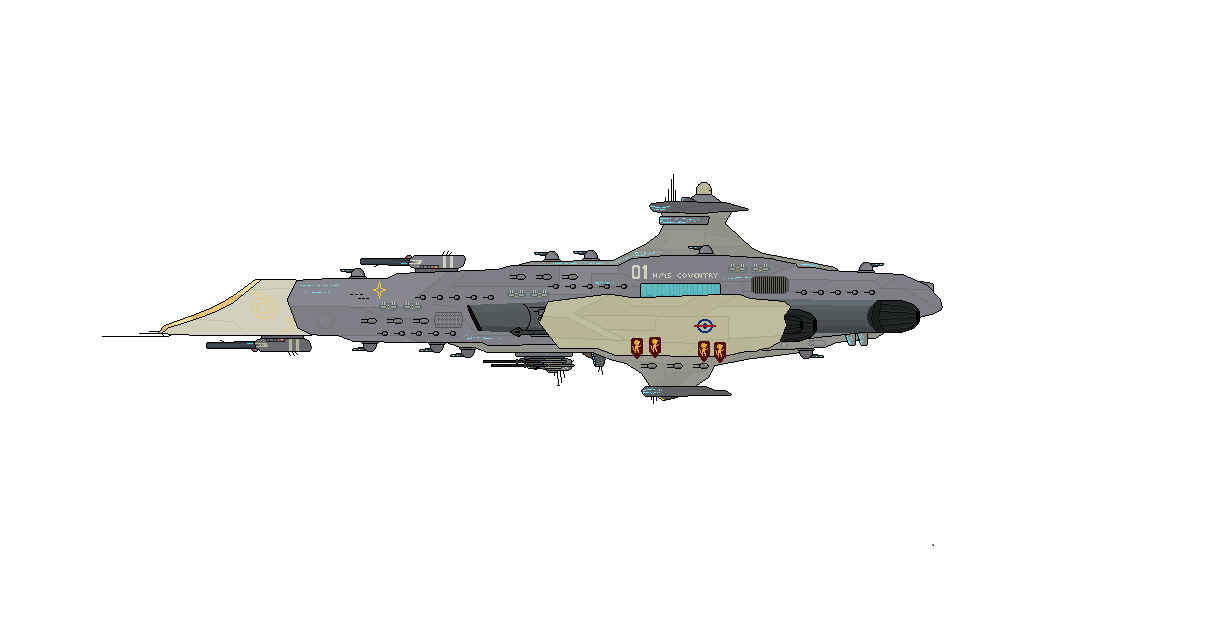
Generation V’s new destroyer. Evasive and agile. The lack of firepower, a spinal mount it makes up for with shielding and evasion, making Coventrys extremely hard to take down. The AI has been improved and it displays actually capable close-range capabilities. It is tanky from the front with its front armour ram. The ship does however have a lack of radiators. Though since the ship has a minimum amount of guns to fire it is often not an issue unless the engines are on a high power setting during prolonged periods of time.
Length: 1 km
Colony-class destroyer:
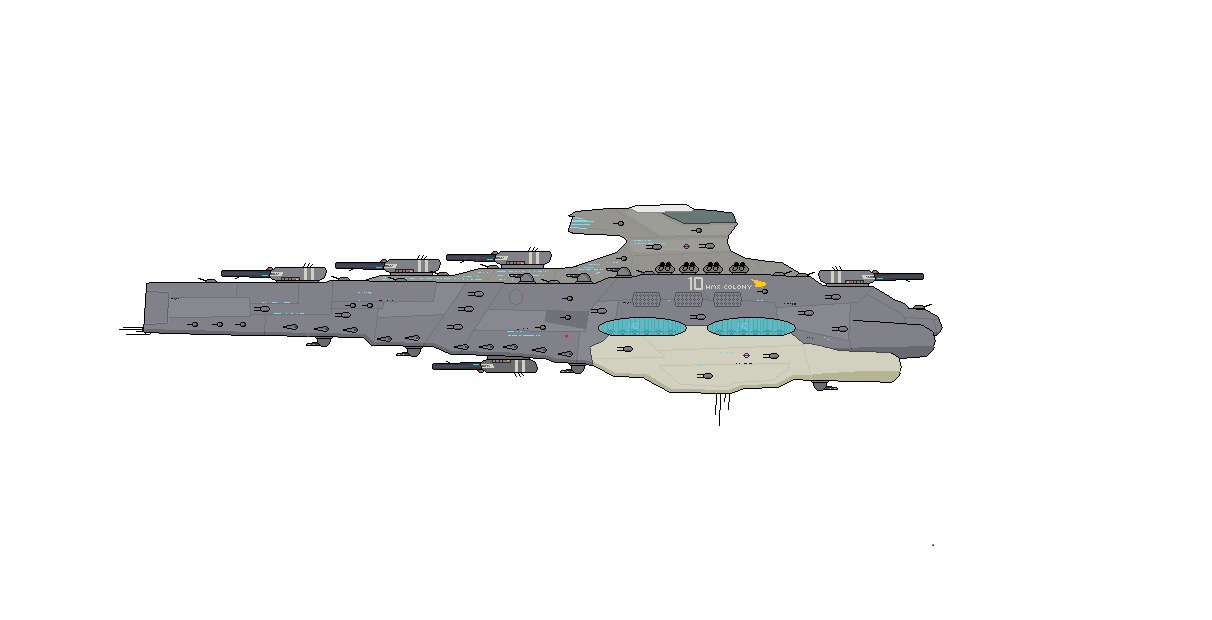
One of the newer additions made to replace the Solaric, it has a large armament of torpedoes and turrets. Its Lance is smaller than usual. It leans more towards shields than armour than normally. The Colony carries heavy thrusters. It’s a part of the fourth generation of GBE ships. The ship was initially a concept for the Moonlight-class, the director of naval production liked it so much they made it into another ship.
Length: 1 km
Solaric-class destroyer:
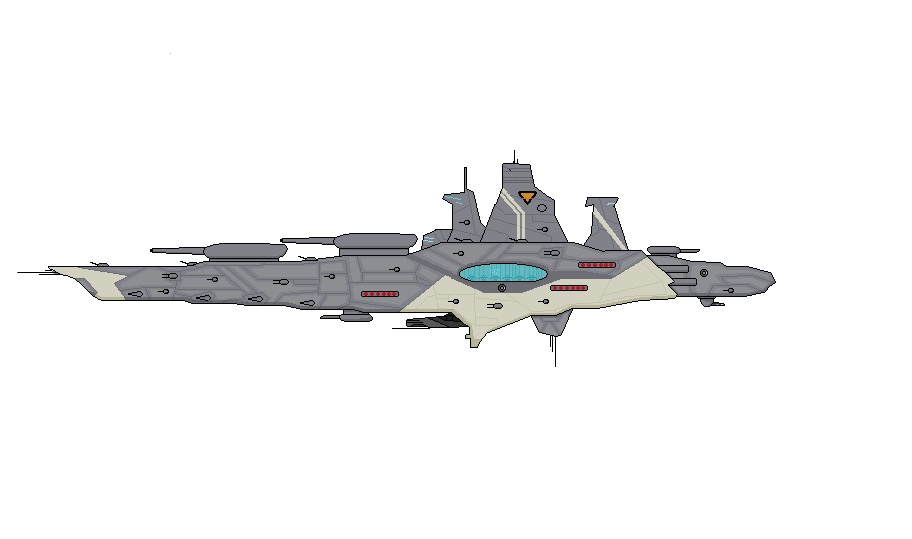
One of the more iconic ships though its mainstay role was going to be handed to the Moonlight then the Sunrise-class and now the Eclipse-class. But it will still play an important role in the navy. It balances out cannons, turrets, point defence, missiles and torpedoes. Its armour is reinforced but not as strong as the other ships in the navy. It is becoming old and will be entirely replaced by the Colony-class outside of the reserves when the new fleet is completed. The Solaric remains the only BAe in-service combat ship sold outside the GBE in the post-Golden era.
length: 1 km
Resolve-class destroyer:
The GBE realized that during gen V as the Solaric was being forced out of service that they needed a cheap all-round multi-role and flexible destroyer that could operate at a lower scale and lower maintenance cost than the Eclipse. BAe quickly designed the new Resolve destroyer, a modular, effective, cheap and adaptable destroyer with high refit capability. Heavy armour, slow forward acceleration, ok firepower (particle lance) and good evasion allows for the Resolve to be used in a combat scenario while being compatible with fleets. Escort, long-range patrol, large scale patrol, small scale operations base, fleet combat, evac, hit and run assaults, you name it, it can do it.
length: 1 km
Anrillia-class escort:
The Anrillia-class introduced a new class to the GBE. The escort-destroyer. A quick, agile and heavy-hitting ship used for the protection of specific target ships. The Anrillia-class is fast, quiet and deadly. It excels at close and medium range. It has positron beam cannons and a spinal early variant ETA cannon.
Length: 1 km
Monarch-class stealth escort:
The monarch is an advanced stealth escort-destroyer. It hides from detection systems and it’s perfect for ambushes or traps. The ship's weaponry is effective at long and medium ranges while its broadside is great at point-blank. It has a strong missile alpha strike, and guns for firing in every direction. It hides with an outside layer of PCTM, a stealthy geometry, running low on most electromagnetical emotions.
Length: 1 km
Obliviate-class Destroyer:
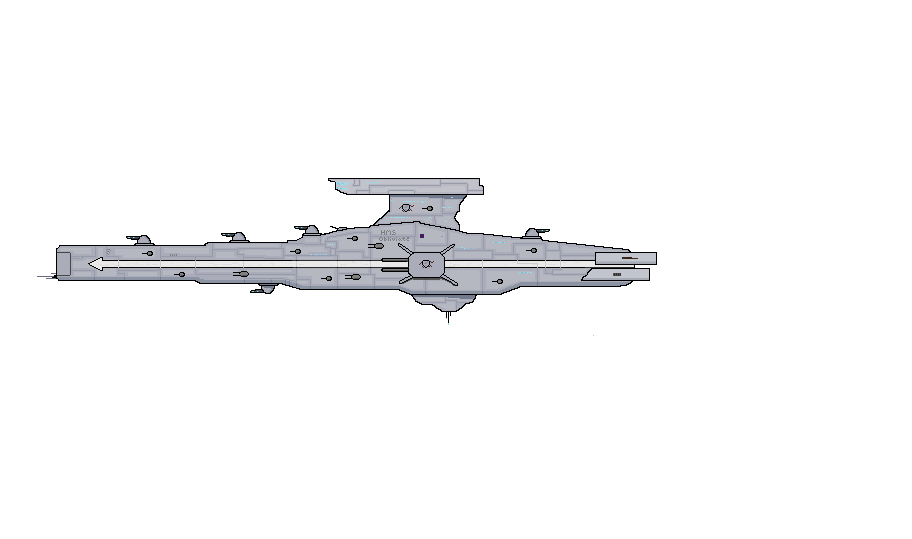
The obliviate class has the new blue flamed thruster engines and single cannon turrets making it the ideal weapon in flanking manoeuvres. The destroyers can lay down an incredible amount of fire. It isn't armed with torpedoes or missiles to maximize on the guns. It doesn't use reinforced armour but uses a UPR produced advanced shield to protect itself. It is armed with the Lance in the "nose" section. The ship is very unusual and rarely seen.
length: 700 m
Storm-class bombardment ship:
The storm class is a small and agile bombardment ship. It is quite fragile and armed with a few powerful railguns on the bottom. The ship is very manoeuvrable and equipped with quite a lot of point defence. The shields are more powerful than the armour by quite a margin. The ship needs a larger flagships computer system to calculate where its own projectiles will land and where the ship should go to evade incoming fire. It uses mobility to its advantage, something planets don’t have.
length: 700m
Sython-class frigate:
A new frigate equipped with a lance and a high amount of point defence. The ship isn’t very common as it doesn’t serve an effective role in large scale fleet combat. It is used in patrols and hunting pirates.
Length: 600 m
Stantine-class frigate:
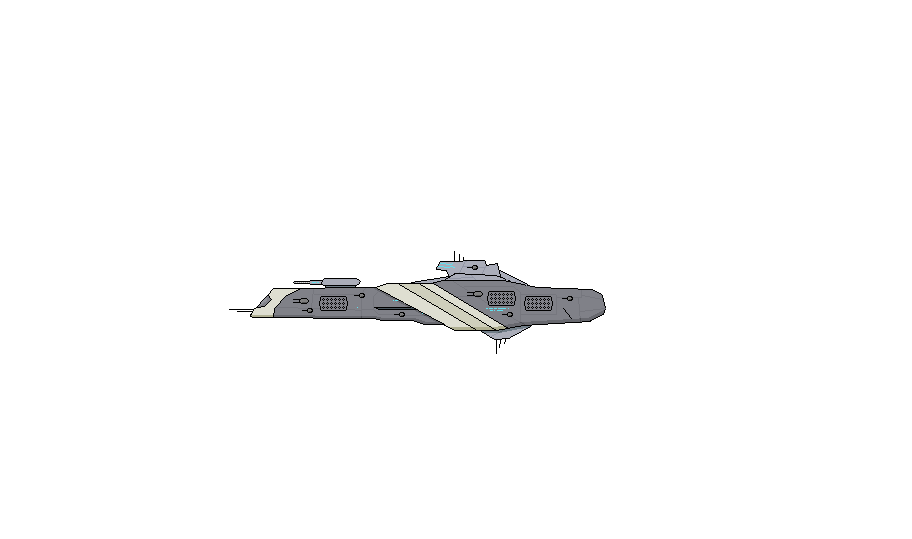
Named after Stantine himself the missile frigate lays down support fire during a battle. It only has one dual cannon turret but is heavily armed with thermo-nuclear missiles. It’s a support ship that can project shields in front of other ships in the fleet.
length: 550 m
Stargazer-class frigate:
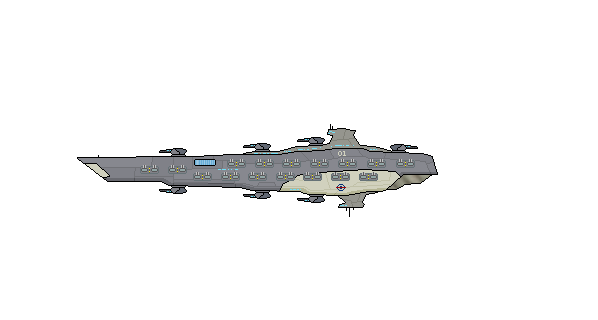
This frigate is armed to the teeth. The new launchers allow for varying payloads. The ship can intercept projectiles, destroy fighters and launch long-range nukes. The Stargazers armour is very weak so it relies on speed to evade danger. Despite being a frigate, an overlooked class by the enemies, this ship is a danger to any fleet. Any enemies who see a Stargazer should be as afraid as if they saw a Sunrise.
River-class littoral combat ship:
Previously known as the multi-purpose carrier, this ship the size of a small frigate is used to extend the GBE's influence. The ship is capable of operating and patroling far from base and extending the range of strike craft. Littoral combat ships may be seen when the GBE attempts to control an area of suppressing targets far away from GBE territory.
length: 340m
Wasp-class corvette
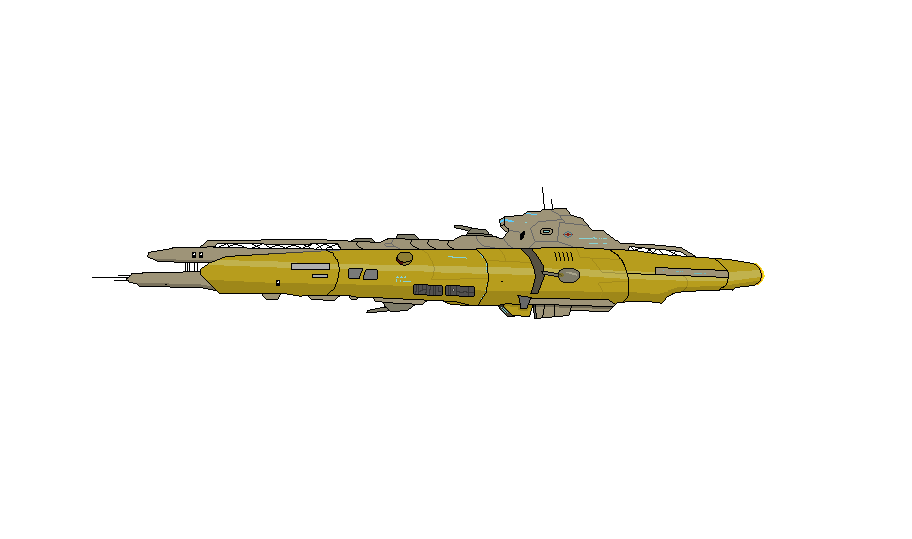

In case the GBE fighters are unable to deal with enemy fighters the corvette is armed with almost only point defence to defend the fleet. Refit mk III gives the corvette spinal railgun to be used against enemy capital ships.
length: 260 m
Redeemer-class corvette:
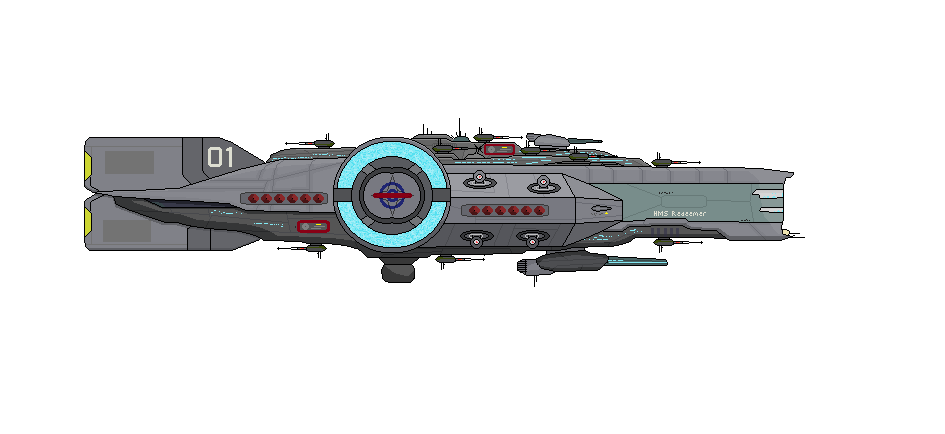

The Redeemer is one of the newest ships to come to the GBE. It was described by one of Admiral Blue’s officers as “annoying as frig, more deserving of the name ‘wasp’.” The ship is very fast with acceleration and max speed. Its signature can be masked for brief moments confusing enemy sensors. It has point defence cannons for missiles and fighters, missiles and projectiles. It also has a large superplasma cannon for doing damage to capital ships at point-blank. The shields are rather heavy and armour somewhat light.
length: 260 m
.
Technology:
Weapons:
Cannons:
The standard legacy cannons are generally on turrets as batteries. They are heavy rail- or coilguns that fire shells with nuclear explosive payloads (HE) or without (AP) (sometimes ion, incendiary, atmospheric or interception shells). Gen VI upgrades the standard shells' nuclear explosives to VIMY type warheads and adds newer types of shells. The most common are flak, cluster munitions, casaba delivery system, magnetic decay shells and missiles (shells with improved guidance). The shells are set to explode while penetrating into the target or to hit slightly or right after the slug hits the shield or armour. Calculating the moment the shell hits the target is impossible; they will set a proximity or impact fuse. The shells use plasma fusion warheads as a default warhead. The compartment with the explosives is detached and a laser fires at a reflective object, which reflects the radiation, which pushes the explosives slightly behind the shell to not be obliterated upon impact or interception and instead detonating after the shell impacts. As the shells of main and secondary capital-grade batteries are so dense and large, interception of them requires a large amount of energy. As an addition to gen VI, all main and secondary batteries' main ammo must have guidance. While not being able to fully manoeuvre like a missile, it allows the shell to make small adjustments that over range makes large differences and makes evading them harder.
Railguns: Railguns are the bread and butter of GBE weaponry serving as both main batteries and high-rate/volume of fire autoweapons.
Coilguns: Coilguns are an upgrade to the legacy railguns, essentially being a more effective and stronger railgun. They can fire shells faster and quicker with improved cooling. As they are superior to railguns they essentially replace them on gen V ships and above.
Gravitcannons: Were first considered a failed technology, gravicannons were just a much less effective version of a railgun, though the GBE is trying to develop a more effective variant as it sees that the graviton cannon has more potential. However, graviton support has been implemented in order to bolster and accelerate railgun or coilgun shells even more. Though it is doubtful that a weapon that uses gravity as its primary acceleration is unlikely.
ETA cannon (Coil gun propelled plasma torch accelerator): Electromagnetic torch accelerators are a gen VI addition used primarily in large main battery or secondary battery turrets. An ETA cannon fills the plasma with torch drive fuel (hydrogen) on the brink of burning. As the shell is accelerated by a coilgun into the barrel at hypersonic speeds, the compression from the shockwave burns the fuel, which shoots out of the barrel also assisted by the electromagnetic coils, essentially pushing out the projectile with the generated plasma as if it had a plasma thruster. This allows even the relatively early ETA cannons to surpass coilguns. An additional advantage with ETA cannons is that the plasma heats up the shell when exiting the barrel that the shell's material passes the Curie point and loses its magnetism. Because of this it is not affected significantly by magnetic shields. To not damage the explosives or manoeuvring segment, the shell has a discarding protective layer around them.
Lance: The GBE neutral particle lance fires a sustained beam of particles toward the target through an artificial redirection crystal that maximises range. As the crystal is produced with accuracy down to every single particle, the production cycle is long and expensive. The Bastonian lances work exceptionally well at long range since the beam is highly focused. The lance is very power-hungry and cannot hold sustained fire for long. It takes considerable energy to charge up.
Nuclear-boosted particle lance (casaba accelerator): a spinal particle accelerator coupled up with a VIMY fusion casaba howitzer that fires the output of a large nuclear explosive as a focused beam which is greatly more powerful than a standard GBE particle lance. As the nuke detonates it releases a wave of plasma, some of which needs redirection assistance from electromagnetic fields. A long plasma propellant absorbs the blast and turns itself into plasma which reaches high velocities. The plasma is then focused by a magnetic lens into a particle accelerator where the plasma is accelerated to a significant portion of the speed of light and focused into a narrow beam. As it is about to exit the nozzle an electron stream neutralises the plasma to prevent bloom and increasing the range of the weapon. Another factor adding to the range is time dilation which increases with the velocity. The beam’s heat will dissipate over time but it will not lose kinetic energy. As the beam is travelling so quickly the plasma reaches its target before major energy loss has been achieved. Another plus side is that radiothermal generators from the detonation can help with powering the accelerator allowing for increased fire rate. Downsides however are that it requires ammunition and the necessary logistics for it. The detonation case is also maintenance heavy.
Torpedoes: Are armed on most ships. A torpedo is essentially a massive missile with its own shields, ECM and point defence. They carry a heavy payload of sustained fusion explosives or antimatter warheads. Each launcher can load about two torpedoes.
Cruise missiles: Are armed on larger ships. These missiles have extremely long range and certain types can be launched from another sector. They can be armed with their own warp drive. The shields are often quite powerful as they have to be launched against entire fleets worth of point defence. A GBE ship has to be quite large (destroyer or above) in order to carry cruise missile launchers that can only load one. Typically cruise missiles have large clusters of nuclear warheads, anti-matter or are relativistic kill missiles,
Ship-Ship Missiles: Missiles are a common weapon within the GBE. The missiles have fusion plasma explosives. Pure fusion nukes are launched in massive swarms causing devastating damage. Gen VI missiles are larger and better protected with shields and decoys. They field VIMY fusion warhead which essentially boosts the fusion of a central warhead by detonating a surrounding array of thermonuclear warheads.
Point defence: If the highly advanced fighters were not enough, ships, especially corvettes ,are equipped with accurate point defence systems for taking down fighters and torpedoes. The point defence can vary from lasers to kinetic. The earlier ships used kinetic point defence but GBE has come to prefer lasers.
Casaba howitzer: When BAe systems requested the development of the casaba howitzer to the director of naval weapon development she heard the words N U K E G U N she immediately approved. Or so the rumours say. The casaba howitzers are essentially a plasma gun that turns the power of a fusion explosive into a projectile of plasma. GBE utilises electromagnetic fields to fire casaba howitzers in an arc where the shots fly in an arc upwards before turning and flying down onto the enemy ship (art purposes, no actual functionality). It is quite possibly the only standard weapon that is not made for long range combat on Royal Navy capital ships.
Defences:
Particle shields: The Great Bastonian Empocracy relies mostly on armour to protect their ships even though their standard shields were originally produced by the UPR. GBE standard particle screen shields generate an encasing of engineered Phorion-particles to create a solid barrier around the ship. The particles constantly deteriorate and constant power is needed to the generators in order to generate from projectors when an incoming projectile is about to hit the ship. The shields are stacked in layers. Each layer is actually two different particle screens. The first layer consists of a shield that is only aimed towards stopping lasers and near-speed-of-light particle accelerators. The second is effective against ballistics such as nuclear explosives and conventional explosives as well as plasma weaponry.
Plasma shields: Typically the lowest level of shield, is most often not online in order to save power. Used against energy weapons. Generation VI ships typically replace the particulate layers against lasers and particle beams with a primary plasma shield.
Gravity shields: Gravity shields generate gravitational waves that make ripples in space-time. These are generated through the acceleration of mass. This is done by oscillating a massive orb which creates very weak ripples. However at long range the change in direction from the ripples will be significant enough for the projectile to miss. When in a fleet, the ships armed with grav shields (frigates and above) will coordinate to add up each other's effects. Because of the kinetic energy required they shield is very power hungry.
Armour:
The Empocracy has an exceptional understanding of armour and have every effective combination of materials, mostly artificial and rarely natural, you could think of. GBE utilises “particle composite” armour. Most legacy GBE armour combinations are more effective against energy weapons than kinetic, however, generation VI armour focuses primarily on lasers for energy weapons, otherwise the armour is mainly focused on kinetics including kinetic particle beams. Each layer varies in thickness, however layers that repeat may have different thicknesses based on the calculations and simulation of the most powerful quantum computer AI in the nation for their conclusions to maximum flexibility and effectiveness. While a main strikeplate may be relatively thick, nanocomposites may arise where neosteel layered with other metals and superplastics are packed together in sections with space in between. In total the armour of capital ships is very thick and massive. Internet protection like spall liners, superconducting faraday layers and radiation shielding are located throughout the ship internally around certain sections. The medical bays would have intense radiation shielding and faraday layers while the reactor might have additional spall liners and faraday layers. Standard capital ship grade armour uses all materials/layers below:
Neosteel: Armour generally has a layer of part neosteel, a rare resource that needs refining that is extremely durable and not that heavy. The neosteel after refinement is compressed to the extreme. Neosteel after the GBE’s entire process is so dense it requires anti-gravity generators to not mess with gravity inside the ship. Neosteel is compressed through a similar process to KAEPA and with electromagnetism, with extreme precision to create an almost crystalline structure. Mass driver may also be used to smash pieces of neosteel together at relativistic speeds early on in the refinement process. Each molecule has one of their electrons replaced with an artificial subatomic particle with a much higher mass similar to muons which is assembled from quark level, which drives the atoms closer together allowing for the atoms in the molecules to be situated closer together. Neosteel molecules have an extraordinary amount of bonds shortening the bond length dramatically. Because of the stability of each of the neosteels components, it is very hard for neosteel to undergo fusion making it ideal for extreme compression and armour against weapons that fuse with a ship's hull. Neosteel is hyperdense, stable and extremely hard and is used as strikeplates and doubles radiation shielding.
Carbium: The GBE has manufactured a 3d carbon lattice. The atoms are modified on particle levels to make sure they can be as tightly packed together in the lattice as possible, creating an extremely strong layer of armour. The carbon atoms that make up the lattice have negatively charged particles assembled synthetically that act as a “reverse shielding effect” that pushes the valence electrons closer to the nuclei and reduces the atomic radius. As it is lighter than neosteel it is used as a lighter strike plate and is prevalent in spaced armour.
Agnosite: Agnosite is an artificial metal that distributes and absorbs heat well. Lines of heat superconductors go from Agnosite to the ship’s thermal generators and thermal ludge or the auxiliary radiators to waste the heat. Agnosite mesh threads through the armour preventing lasers from localising their heat into one area of the armour and spreading it out across the ship, eventually dumping the heat into radiators or molten salts.
Hardlight layer: Between two solid layers, there’s one layer which is a medium of gas where a hardlight shield is located. The shield does not cover the entire ship however but it is moved to different locations around the ship to stop projectiles. While the layers itself may act as spacing for armour, the hardlight shield can be positioned in the same area as multiple layers of shielding.
Latision-carbide: This material is a synthetic refractory ceramic with an extremely high melting point and heat resistance. The material is also hard and can be used as spaced armour. Often it is combined into a composite with layers of aerogel.
Ablative foaming: consists of aluminium with neosteel balls within it. It is structurally supported by “nets” of graphite. The ablative layer is designed for ablation of kinetic projectiles and the scattering of lasers. The aluminium may in some layers be replaced with aerogel for more thermal protection. This armour layer is very thick but also light.
Electric reactive armour: *IRA is a type of reactive armour that consists of supercapacitors with superconductors. They work by discharging enormous amounts of electricity into a projectile, vaporizing it and significantly diffusing the attack. It works very well against plasma and kinetic weapons.
Shock absorber: Flexible superplastics or carbon polymers as structural and shock absorbing layers. Layers of shock absorbers and sandwiched between almost every hard or is made as a mesh that structurally supports layers
Replaceables: This is a set of artificial materials that are used for quick or mid-battle “patchups” of armours. Which consist of materials that can be melted into a liquid and injected into holes on destroyed parts of armour that turn solid when dumping heat into the superconductors. Replaceable armour materials may be a less effective version of certain armour materials or simply act as a medium to fill in the gaps for attaching solid armour pieces. Attachable chunks of reactive armour are also considered replaceables.
Other: Spall liners are used. Shock absorbing bulkheads are installed to mitigate impacts to the armour. Armour add on may include whipple shields and explosive reactive armour. Certain ships may have formed penetrator reactive armour.
Force interdiction: Interdiction is a very advanced piece of tech. It can stop ships from entering any type of FTL travel and pull ships out of it to a specified location. That location is the focus point of the interdiction field. When being thrown into the focus point the ship or ships may always be a certain distance away from other gravitational anomalies. The more mass the object has, the further away the ship exists FTL from it. Because of this it cannot be used to ram ships into each other or make ships fly into stars or planets.
Blanket interdiction: blanket interdiction is a type of interdiction that prevents FTL through it. A ship that hits blanket interdiction will exit at its border. Blanket interdiction nodes are an extremely cheap type of station or probe that creates a networked interdiction net. The net can be controlled to create openings in the field.
PCTM (Photon Collection Trap Material): A type of synthetic material used on the outside of most ships' armour that “charges” up by absorbing photons and storing them in traps. The material is vantablack as it absorbs all light that touches it until the traps reach maximum capacity and the material returns to its normal colour. When there is incoming fire an electric pulse is used to trigger the photons to be released in a hardlight barrier that lasts a few seconds. Not all the photons are released at once so it can be triggered for some time or multiple times. The barrier is quite brittle and can help with incoming kinetic projectiles, it is also effective against certain lasers as it can absorb and release photons and cool down quickly before being overwhelmed. PCTM has to be charged by being exposed to light or photons. Light sources generated by the ship of a station are far too weak and therefore for effective charging of the PCTM the ship has to be exposed to a star, though it doesn’t have to be closeby. Newer PCTM systems have a vast laser cooling system with millions of tiny lasers embedded beneath it. These serve as cooling to get the photons to gain more mass but also to eliminate the high amount of heat absorbed by the material. This allows for PCTM to be an extremely effective radar absorption material. Because it can absorb photons it means it can mask a craft from a large selection of detection systems, including infrared, x-ray, gamma and optics detection systems. The lasers can be reconfigured with high power where they can instead charge the PCTM with their own photons.
I-net:
An Interception net is the term for all the defensive capabilities linking up and using information from all ships in the fleet to protect from incoming fire. Gen VI introduced the idea of an enclosed fleet I-net or single ship I-net which would supplement the capabilities of existing PD and evasion. With combined information and better coordination, more tools and weapons to use the I-net of gen VI ships are highly potent defences. What makes an I-net superior to earlier GBE defensive capabilities are the addition of large PD ship screens, flak screens, increased missile interceptability from fighters, more powerful PD and I-net defensive drones. Earlier laser PD and kinetic APS were the only reliable interception systems for GBE ships.
Flak and cluster bomb screens: A new type of ammunition increases the effectiveness of the use of main batteries or autorailguns as flak munitions as the shell is shattered from the inside launching its fragments at relativistic speeds that can cover large areas. Increased size and use of defensive missiles with cluster munitions.
Bomb pumped laser: a much larger and more powerful defensive weapon that the standard laser PD, these are commonly seen on I-net assistance vessels like escorts or frigates. They can intercept much larger shells or heavy missiles and disrupt plasma, hardlight and certain particle beams.
Shield projection: frigates will typically assist by projecting defensive shields at ships that fail to evade. Usually hardlight is used but since gen VI projecting particle screens has become practical. With shared information multiple ships within a fleet may add the effects of their gravity shields together to make evasion routes possible against large amounts of projectiles
I-net drones: The largest addition to the I-net provides powerful interception tools. The drones are practically flying hard-kill APS guns. The burst kinetic drone is armed with a burst cannon that fires bursts of smart shells with a shotgun-like effect geared towards interception of enemy missiles and lighter kinetics. The arsenal drone carries a heavier, slow firing cannon that fires interception rounds that propel a thermonuclear shaped charge, which fires a projectile accelerated by a casaba-howitzer type device that deposits all its energy into a beryllium filter. The resulting blast fires the shaped charge at impressive power. This type of shell is especially useful against very heavy capital-grade shells or weapons that are hard to intercept. The casaba drone is armed with a cheap fission casaba howitzer. This more close-range system utilises a casaba howitzer to hit the target with an intense beam of plasma generated from the detonation of the nuclear device.
Missiles: as the standard size for missiles increases, the legacy standard missile launchers will act as dedicated interception missile platforms on newer ships.
general naval tech:
Radiators: An essential part of each ship. The radiators are where all the heat is dumped, where then it is exposed to space, or a medium such as a liquid metal or molten salts to get rid of said heat. Ships might have auxiliary radiators which are quite vulnerable, though the main radiators are often protected by shields or whatever else. Molten tin may be used as a medium to transport heat between systems to the radiators.
Onboard computing: AI a shipboard takes care of most tasks which traditionally crew would do. The ships computers have to compute sensor-data, tactics analysis, evasion paths, FTL routes, navigation routes etc. As such computers on warships are large and have redundant secondary computers in case of failure or destruction. The main computer is typically linked with a ship captain or fleet commander's brain via their neural link allowing them to take in and compute the same information the AI is receiving and process it within their minds and allowing for an increase in calculations of outcomes. Typically military computer models are typically quantum models which through a mechanical system that uses infinite superposition of states to compute. They are extremely fast and powerful, being able to cycle through or conduct multiple demanding tasks simultaneously.
Heat point cooling: A system in which massive amounts of heat are funnelled into small thin sheets of metal. The system uses laser cooling which covers the entire sheet, no matter how much heat is funnelled into the sheet. However, the sheet must not exceed a certain temperature, at which it melts.
KAEPE reactors: Kinetic artificial ergosphere power extraction reactors are a type of power source which relies on creating a spinning gravitational anomaly with ultra-dense matter and gravity generators to create an artificial ergosphere in which electromagnetic waves are shot through, which gain momentum when entering the ergosphere. The anomaly is surrounded by reflective plates which bounce the electromagnetic waves. Small gaps are opened in the reflective plates, letting out the electromagnetic waves onto plates that convert the kinetic energy. KAEPE reactors are very similar to black hole bombs/reactoes. The reactors are quite unstable and can mess up the gravity in the ship if damaged, which in turn might destroy the ship itself. The energy put into the process of making KAEPE reactors typically come from industrial antimatter reactors. KAEPE reactors can be set to self-destruct in a devastating explosion.
Fusion reactors: typically used for auxiliary or secondary reactors, fusion makes up a significant portion of a ship's power generation. Smaller ships such as frigates and smaller ships may not be able to have KAEPE reactors and as such use fusion as their primary source of energy. Fusion reactors are commonly at the back of the ship, linked directly to the torch drive, providing plasma to it. Cold fusion may also be utilised in stealth ships. Fusion reactors are extremely common in the GBE and with decades of producing them the process has been streamlined and effective making smaller scale fusion reactos very cheap and common in civilian applications.
Sensors: The Royal Navy uses a variety of detection systems. Most common are active/passive hyperfrequency radar and lower frequency high range radar, optical, infrared sensors, LIDAR and FTL detection (detecting ships entering/exiting FTL). FTL sensors such as tachyon sensors and quantum radar which uses entangled photons instead of reflecting radiowaves. Larger ships such as cruisers and above are often equipped with x-ray and neutrino sensors.
Stealth: Royal Navy ships often make no effort to conceal themselves at medium ranges. However, GBE ships do like to be undetectable from further than long combat range. Essentially outside the GBE’s most effective fighting range in order to position themselves properly for engagement. However, there are a few select dedicated stealth capital ships in the GBE. Certain properties of systems used may make GBE ships highly detectable from long ranges with the correct equipment.
Propulsion: The general method of propulsion for ships of the Royal Navy is the torch drive, an engine that propels the ships through accelerating plasma through a particle accelerator. Otherwise, ion engines are used. Ion engines are the most popular choice for stealthier ships as they do not generate as much heat or neutrinos. Ultra-cheap vessels such as patrol craft or drones may use fission drives. For atmosphere jet engines are common.
Faster-than-light travel: Warp space travel or warp travel is a type of FTL travel that requires a warp drive. The GBE warp drives are only fielded by the GBE and make a distinct THUD sound as the ship exits warp space. Warp drives tear a hole through spacetime to create a rift to another dimension where the laws of physics don’t apply the same. The ship travels larger distances relative to realspace in warp space. Warp space is described as a white and sometimes blue tunnel with no end. When entering warp space the ship appears to, in realspace, to accelerate extremely quickly and shoot off into the distance like a projectile. This is visible because the ship has entered the “link”. A stage in between warp space and realspace in which the ship is suspended in both dimensions, making part of the increased speed happen in realspace. The link is a result of realspace “leaking” into warp space and vice versa, creating an effect where the ship is momentarily suspended within realspace that is being subjected to the laws of warp space, but as it is still connected to the rift and normal real space, the ship still remains within real space for this time before it collapses. Ships within warp space generate a bubble of real space around themselves preventing the ship from being crushed. This is done by generating a distinct type of dimensional interdiction which keeps the real space around the ship in place as it travels through warp space. The dimensional interdiction manifests in normal real space. This is called a warp shadow which connects the ship’s positions in warp space to its equivalent in real space. When the warp shadow hits an interdiction field, the ship is ripped out of warp space.
Fighter specific tech:
Guns: Fighters are often equipped with high calibre gatling guns or plasma launcher guns. Sometimes even emp weapons. Fighters can often carry laser pods for intercepting missiles or enemy fighters. Interceptors such as the CDI-5 can carry high power laser pods on their backs or bellies. High power railguns may be set on the bottom of certain fighters.
Missiles: These are the main weapons of the fighters. The missiles are stupidly expensive making continuous battle encourage the GBE to back out their fighters. The missiles use combined information from many different detection systems, as well as using ECM and countermeasures systems in order to prevent targeting. The newest iteration of missiles are even shielded with particle screens dedicated against their lasers or kinetic fire, depending on what was brough. There are also heavier missiles made for taking down capital ships such as the surface wiper missiles that launch a group of warheads that spread out across the entire ship to take out guns on the surface. Torpedoes are anti-capital ship missiles that have long range and good survivability, which hurt the manoeuvrability and speed of the torpedoes. They are often shielded. Most GBE fighters can’t carry any torpedoes with larger payloads however the bombers carry extremely devistating payloads.
Armour: Fighters are not armoured heavily as they would lose their ability to dance around the enemy. This means if the shields are down the ship will most likely get destroyed by a single missile hit or a lucky gun hit. However, the hull of the fighter can however survive for quite long when being shot by a laser. Gen VI fighters have improved survivability with light composites now containing heat superconductor mesh within the aerogel and electroreactive armouring.
.
.
Civilian technology:
Neural link: A type of brainchip that acts as a kind of “brain phone”. It is essentially a computer connected to the brain and the nervous system. It can artificially simulate hormones, experiences and even stop signals to the brain. There are very strict rules for neural links. People travelling into the GBE with unapproved Neural Links cannot enter with them. Neural links sit in slots in the back of the head or behind the ear. Surgery is required to have a chip slot. Illegal neural link smuggling and selling is highly illegal. An alpha Ai system (representing the GBE's and the constitutions will) is specifically programmed to stop monitoring thoughts and location. It stops tracking, broadcasting literally anything the person thinks, feels, sees etc. A neural link cannot be dangerous to remove, no installed software is allowed to track location without the user agreeing. The injection of thoughts, dreams, experiences or others memories is not allowed. It is not allowed to mess with the flow of hormones and general things and signals to the brain (with a few exceptions such as depression and extreme pain), the chip must make sure the user prioritises reality in front of chilling in virtual realities (a lot), the chip cannot store someone else’s memories, memories must naturally decay, the chip cannot increase the thinking speed of said individual drastically, it cannot decrease intelligence or any other ability, it cannot cause unnecessary pain, the chip must not alter memories or thoughts etc. most of all it cannot monitor thoughts or experiences, simulate them, control the individual’s free will and body or make them think a certain way. “Any attempt to breach this AI’s protection will be eliminated, any attempt to end this protocol, even from the state, will be declined for the state is not above the constitution.”
There has been a lot of debate about neural links and the massive disadvantages of not having one, most notably in the education system. It is however extremely uncommon to find someone without a neural link in the GBE.
Xeno-compatibility (cross-race-compatibility): Cross-race-compatibility, perhaps more known as xeno-compatibility outside the GBE, is a technology that allows for different races to have children. With the wonders and glory of genetic modification, different species can finally do the (redacted). Species have to be registered as compatible with approved and tested gene modification so that the child doesn’t suffer from any types of problems or horrors of mixing up species. One part of xeno-compatibility is cross-species crossing. It works like this: only one species of the cross-species is selected for the child. Of course, this requires even more tampering with the fertilized egg. Imagine that an Irri-Human and a Ka-Human had a child. That child could be Irri-Human, Ka-human, Ka-Irri or just plain Human.
Nanohunterphages: A type of nanobot that acts as an immune system. Nanohunterphages are a large upgrade to the GBE previous biomodified bacterio and virophages. Every GBE citizen is to have a nanohunterphage immune system. Nanohunterphages are mechanical machines. They use a variety of methods. Ramming, spraying gas inside bacteria sometimes even guns. Yes, microscopic guns to fight diseases.
Holograms: Holograms is the preferred method of screens in the GBE. Older holograms often only show green or blue. Holograms typically are in colour now. Holopads are the equivalent of mobile phones, other than neural link chips. Holopads are round and quite small with a projector and a holocamera. Flatscreens are also common however mostly in cities of computing devices.
Car: Cars in the GBE can fly within the atmosphere. Anti-grav and jets allow for cars to safely travel. Cars can hover just above the ground, which they might do in many cities, or just to preserve fuel. Cars travel in sky lanes marked by floating glowing markers. Most adult GBE citizens own a car. Cars are only for local travel across a single world.
Wetware: Wetware is a type of living computer that uses neurons. Typically wetware computers in the GBE are linked into people as an extension of the brain. However the practice of installing it requires government approval. Professions that would use wetware would be researchers, engineers and military commanders.
.
Superior Nations of the Spiral:
An ancient precursor nation that keeps their secrets hidden. They vanished mysteriously and the GBE are studying their Psionic tech and abilities.
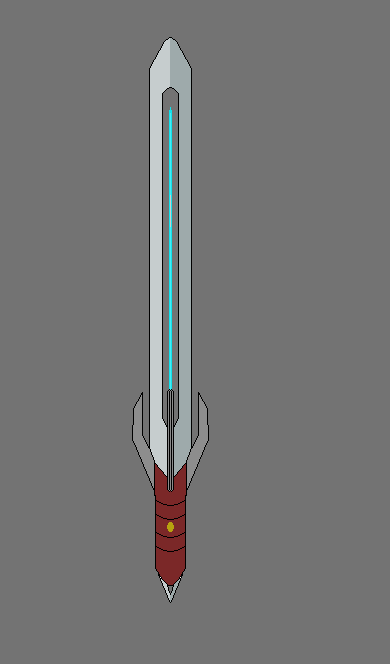
A psi-blade, developed with the understanding of the Nations’ tech
.
Military
Royal Navy:
Defence fleets: The defence fleets are in “”blockades”” around the planets and stations of the empocracy. Their core objective is to make sure no asset of the empocracy lays undefended. Military stations are part of the defence fleet.
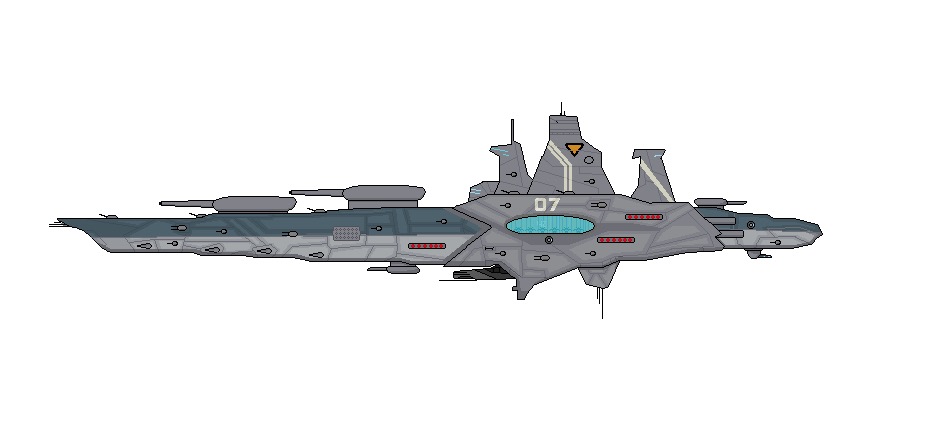
(defence fleet paint scheme)
Assault fleet: The assault fleet’s ships are with the defence fleet or reserve until they get the scramble order, where they rendezvous make a joint force. They are always the attacking force within the empocracy. High ranking members can add ships to the fleet as they like. Assault fleet crew are the most highly trained and all the most expensive ships go to the assault fleet. This is because the defence fleet rarely sees combat. The entire assault fleet is about half the GBE navy. The entire assault fleet has not appeared in any battle as of yet. It is often divided into smaller battle fleets, battle groups, strike fleets, strike groups, task forces, task groups etc.
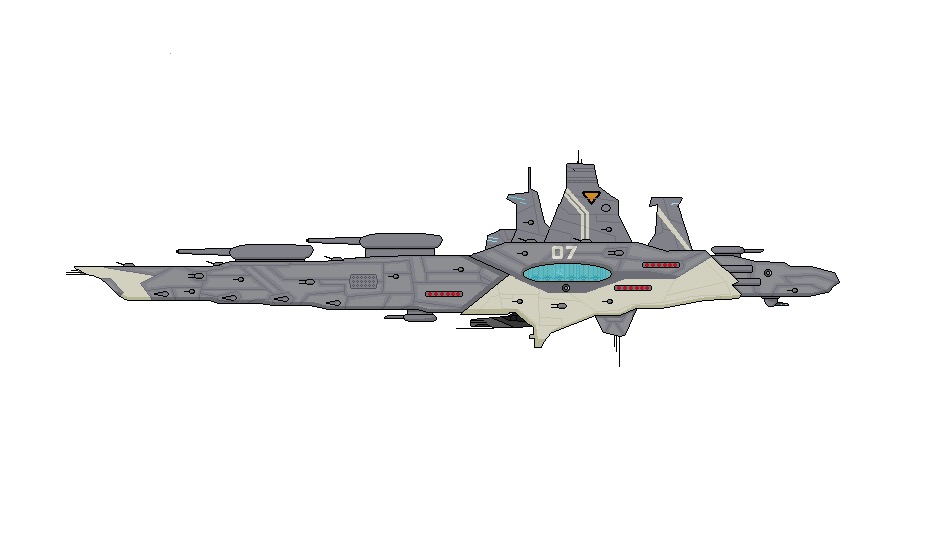
(Assault fleet paint scheme)
Reserve fleet: Out of service when it’s not war to minimise costs. When active they join the defence and assault fleet.

(Reserve fleet paint scheme)
Marines: Part of the assault fleet. Marines are the most well trained and equipped soldiers in the empocracy. They make the army look like kindergarteners. They are specialised troops with various ships at their command, including exclusively marine ships.
SSS: There is little known about the SSS. From what information has been gathered they’re some sort of super soldiers armed with psionic tech. Genetic and biological engineering, quantum computing and psionic enhancement are technologies deeply classified, suspected to be related to the SSS.
Royal Dragoons: A branch of the assault fleet, the Royal Dragoons, with their distinct blue colour scheme, specialise in boarding and extraction operations. It was founded after national hero Commodore Aphani Hadren successfully rescued a large shipping of slaves from an armed slaver fleet. Her task force’s group makes up the Royal Dragoons with the HMS Preserver, HMS Raisonnable and HMS Fortitude as their main ships.
.
Royal Shield:
Home Legions: Often kept as reserves but are responsible for defending their world. Home Legion troopers are often not on duty, just living normal lives just like civilians, going to training about once a month until an order comes in. They then grab their weapons, equipment, mobilize and head to defend their planet. Artillery platforms, vehicles and ground-to-space weapons belong to the Home legions.
Heavy mechanized battalions:
Tanks, Cars and Mechs glimmering in gold. The heavy mechanized battalions are military vehicles supported by a few troops. They are both in the Royal Guard and the Royal shield.
Sky corps:
The Royal Shields “air force” consists of fighters launched from planetary bases.
Adaptable forces:
Used for missions in exotic or alien territory.
.
Royal Guard:
The Guard: The iconic troops in the red armour, capes and energy spears. They stand out with gold and red, with energy shields and tanks with golden wings gleaming behind them. The Royal Guards symbol is an Ethrosian Crownbird, and eagle-like bird of prey, the most popular symbol of High Minister, Admiral, Lord, and Grand Founder Lokion.
Sky Protectors: The navy of the Royal Guards, giant golden palaces with hundreds of red banners, golden crownbirds watching over the floating golden tools of Lokions will.
.
.
The highest-ranking member of the armed forces is Grand Admiral Stantine
The Gate
The gate is believed to be impassable by the GBE. It’s the blockade around the main systems of the GBE. It has a strong interdiction field which only allows one to only warp into a certain location within the system, on top of blanket interdiction. Right into the jaws of the defence fleets. Stations, mines, traps from the High Imperium and alike are placed in the gate.
(named characters so I can remember they exist:
Grand admiral Stantine: he just wants to help people and he likes to spit on slavers
Fleet admiral Phoenix: obese guy who probably doesn't even hate authoritarians
Admiral Estrix: extremely cold person, in reality she just wants to cuddle people
Envoy Arra: probably participates in peace protests
Former-High Minister Jordan Erix: Boris Johnson but even more people hate him
High Minister Kayelin Astra: probably wants to murder everyone, also the leader of the entire GBE
Fordun Cordson: angrier than the average dad, abuses his furniture and probably wants to torture every authoritarian
Admiral Blue: idk he has a big gun and is depressed over it)
.
Relations
Alliances:
the Embassy:
(a lot of people)
Union of Judgment:
Redford Republic - @BattleCruiserCommander
Jinaris Empire - @ShadowZero
United Earth Government - @Flubbery
Vaiaelon War Pact - @Soundbust11
Galactic Federation of Mantle - @HarryRocks101
allies:
Redford Republic - @BattleCruiserCommander
United Earth Government- @Flubbery
Vaiaelon War Pact - @Soundbust11
Enemies:
Thrawn’s Infinite Empire - N/A
Bloodcult - @Drakador_Chaos
Crimson Imperium - @kola2134
Pact of the old blood:
Infinite Dominion - @Brank
German Space Regime - @boombox
